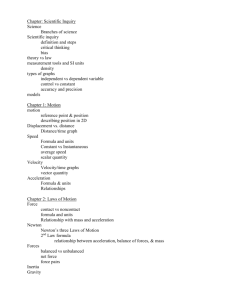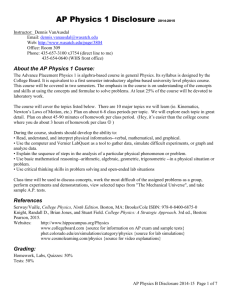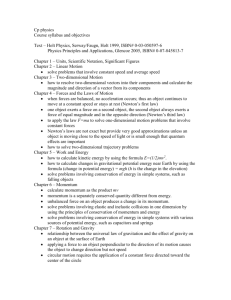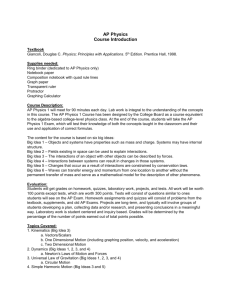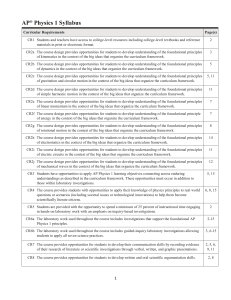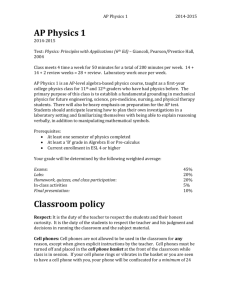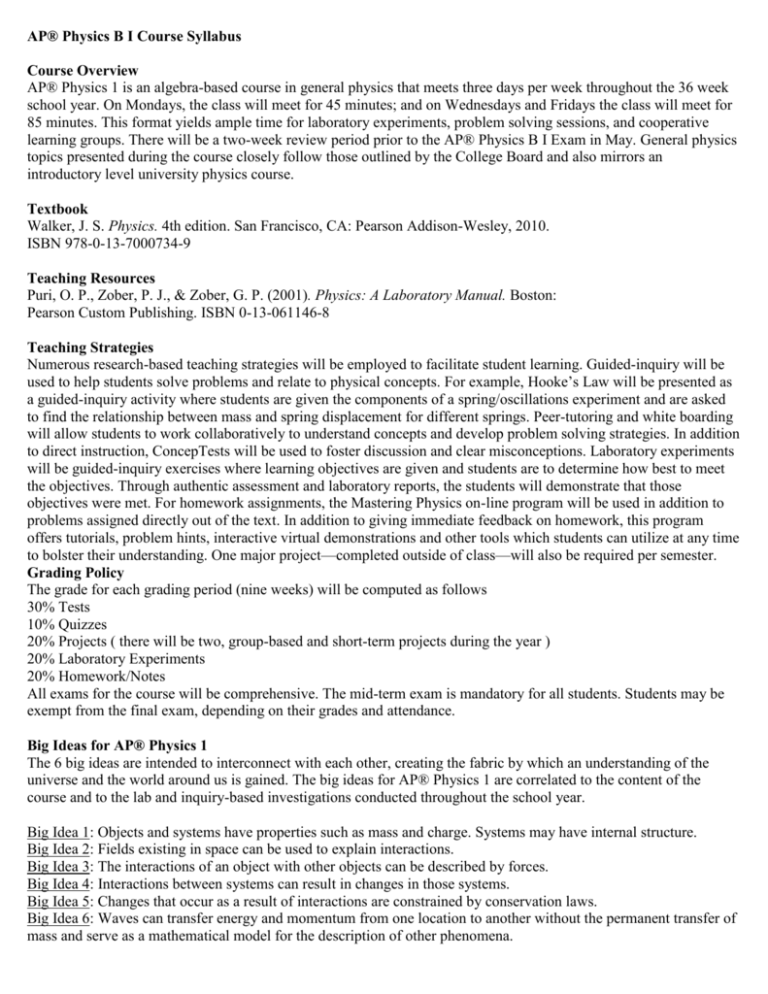
AP® Physics B I Course Syllabus
Course Overview
AP® Physics 1 is an algebra-based course in general physics that meets three days per week throughout the 36 week
school year. On Mondays, the class will meet for 45 minutes; and on Wednesdays and Fridays the class will meet for
85 minutes. This format yields ample time for laboratory experiments, problem solving sessions, and cooperative
learning groups. There will be a two-week review period prior to the AP® Physics B I Exam in May. General physics
topics presented during the course closely follow those outlined by the College Board and also mirrors an
introductory level university physics course.
Textbook
Walker, J. S. Physics. 4th edition. San Francisco, CA: Pearson Addison-Wesley, 2010.
ISBN 978-0-13-7000734-9
Teaching Resources
Puri, O. P., Zober, P. J., & Zober, G. P. (2001). Physics: A Laboratory Manual. Boston:
Pearson Custom Publishing. ISBN 0-13-061146-8
Teaching Strategies
Numerous research-based teaching strategies will be employed to facilitate student learning. Guided-inquiry will be
used to help students solve problems and relate to physical concepts. For example, Hooke’s Law will be presented as
a guided-inquiry activity where students are given the components of a spring/oscillations experiment and are asked
to find the relationship between mass and spring displacement for different springs. Peer-tutoring and white boarding
will allow students to work collaboratively to understand concepts and develop problem solving strategies. In addition
to direct instruction, ConcepTests will be used to foster discussion and clear misconceptions. Laboratory experiments
will be guided-inquiry exercises where learning objectives are given and students are to determine how best to meet
the objectives. Through authentic assessment and laboratory reports, the students will demonstrate that those
objectives were met. For homework assignments, the Mastering Physics on-line program will be used in addition to
problems assigned directly out of the text. In addition to giving immediate feedback on homework, this program
offers tutorials, problem hints, interactive virtual demonstrations and other tools which students can utilize at any time
to bolster their understanding. One major project—completed outside of class—will also be required per semester.
Grading Policy
The grade for each grading period (nine weeks) will be computed as follows
30% Tests
10% Quizzes
20% Projects ( there will be two, group-based and short-term projects during the year )
20% Laboratory Experiments
20% Homework/Notes
All exams for the course will be comprehensive. The mid-term exam is mandatory for all students. Students may be
exempt from the final exam, depending on their grades and attendance.
Big Ideas for AP® Physics 1
The 6 big ideas are intended to interconnect with each other, creating the fabric by which an understanding of the
universe and the world around us is gained. The big ideas for AP® Physics 1 are correlated to the content of the
course and to the lab and inquiry-based investigations conducted throughout the school year.
Big Idea 1: Objects and systems have properties such as mass and charge. Systems may have internal structure.
Big Idea 2: Fields existing in space can be used to explain interactions.
Big Idea 3: The interactions of an object with other objects can be described by forces.
Big Idea 4: Interactions between systems can result in changes in those systems.
Big Idea 5: Changes that occur as a result of interactions are constrained by conservation laws.
Big Idea 6: Waves can transfer energy and momentum from one location to another without the permanent transfer of
mass and serve as a mathematical model for the description of other phenomena.
Course Outline
The big ideas each topic relate to are given with each topic.
I. NEWTONIAN MECHANICS
A. Kinematics
1. One-dimensional ( BI: 3,4 )
2. Vectors ( BI: 2 )
3. Two-dimensional ( BI: 3,4 )
B. Newton’s Laws of Motion
1. 1st law - Static equilibrium ( BI: 1,2,3,4 )
2. 2nd law - Dynamics of a single particle ( BI: 1,2,3,4 )
3. 3rd law - Systems of objects ( BI: 1,2,3,4 )
C. Work, Energy, and Power
1. Work, kinetic energy, and work-energy theorem ( BI: 3,4,5 )
2. Forces and potential energy ( BI: 3,4,5 )
3. Conservation of energy ( BI: 3,4,5 )
4. Power ( BI: 3,4,5 )
D. Linear Momentum
1. Impulse and momentum ( BI: 3,4,5 )
2. Conservation of linear momentum, collisions ( BI: 3,4,5 )
E. Circular Motion and Rotation
1. Uniform circular motion ( BI: 1,2,3,4 )
2. Torque and rotational statics ( BI: 3,4,5 )
3. Rotational kinematics and energy ( BI: 3,4,5 )
4. Rotational dynamics and conservation of angular momentum ( BI: 3,4,5 )
F. Oscillations and Gravitation
1. Simple harmonic motion ( BI: 3,5 )
2. Mass on a spring ( BI: 3,4,5 )
3. Pendulum and other oscillations ( BI: 3,4,5 )
4. Newton’s law of gravity ( BI: 1,2,3,4 )
5. Orbits of planets and satellites ( BI: 1,2,3,4 )
III. WAVES
A. Wave Motion (including sound)
1. Traveling waves ( BI: 6 )
2. Wave propagation, superposition ( BI: 6 )
3. Standing waves ( BI: 6 )
4. Sound ( BI: 6 )
IV. ELECTRICITY AND MAGNETISM
A. Electrostatics
1. Charge, conservation of charge, and electric force/Coulomb’s Law ( BI: 1,3,5 )
2. Electric fields, electric potential, and ( BI: 1,3,5 )
B. Electric Circuits
1. Current, resistance, Ohm’s law, power ( BI: 1,5 )
2. Steady-state direct current circuits with batteries and resistors, Kirchoff’s laws ( BI: 1,5 )
3. Capacitors in steady state circuits ( BI: 1,5 )
Laboratory Experience
Laboratory experiments are an integral part of the course and will be conducted as guided inquiry exercises.
Laboratory work will provide students with the opportunity of spending a minimum of 25% total class-time on handson activities. Students will work in groups to conduct experiments but each student will be expected to write a report
in his/her lab notebook for each of the experiments. The format and guidelines for each report will be provided by the
instructor, but students will generally be required to organize the experiment, collect data, perform calculations,
analyze data and write conclusions. Some laboratory experiments will be teacher-led while others will be student-led (
or inquiry-based ).The final required laboratory experiment will consist of an open-ended inquiry lab where students
determine their own objectives (with instructor approval) prior to designing and conducting the experiment.
Experiments
Kinematics
1. Graph Matching [ guided inquiry ] – Students will be given several graphs—encompassing position,
velocity, and acceleration versus time—and will make attempts to match the graphs by moving away
from and toward a motion detector at various rates. Science Practices 1,2,3,4,5,6,7
Big Idea 3
2. Reaction Time [ guided inquiry ] – Students will test their reaction time by catching meter sticks
dropped by partner; however, they must devise a method to convert from displacement—of meter stick—
and actual reaction time.
Science Practices 1,2,3,4,5,6,7
Big Idea 3
3. Motion - Record and graph displacement versus time data, with ten 10 m sections, but by continuously
varying the constant velocity of each section(slow to fast in that order). Generate velocity and
acceleration graphs.
Science Practices 2,5
Big Idea 3
4. Vector Addition [ open-inquiry ] – Students must find the distance between two points—with a large
building in the way—by using their knowledge of vectors and vector math.
Science Practices 1,2,3,4,5,6,7
5. Projectile Motion – Students analyze video of a basketball being shot, and are asked to analyze aspects
of the basketball shot and subsequent bounces—including aspects that are not shown directly in the video
such as the distance covered between second and third bounces.
Science Practices 1,2,3,4,5,6,7
Big Idea 3
Dynamics
6. Coefficients of Friction - Students determine what effect an incline has on the value of friction and
determine coefficients of friction for various objects.
Science Practices 1,2,3,4,5,6,7
Big Idea 1,2,3,4
7. Atwood Machine – Students determine the acceleration of a hanging mass and the tension in the string
Science Practices 1,2,3,4,5,6
Big Idea 1,2,3,4
Universal Law of Gravitation and Circular Motion
8. Uniformly Accelerated Motion on an Inclined Plane - Students use ramps at different angles to
examine the effect on acceleration of a rolling object
Science Practices 1,2,3,4,5,6,7
Big Idea 1,2,3
9. Whirligig – To determine the tension in the string and the centripetal acceleration of a flying toy
Science Practices 1,2,3,4,5,6,7
Big Idea 3,4,5
Simple Pendulum and Mass-Spring Systems
10. Pendulum Lab [ guided-inquiry ] - Students determine the factors affecting pendulum period and
dervice the formula for the period of a pendulum
Science Practices 1,2,3,4,5,6,7
Big Idea 3,5
11. Hooke’s Law – Students determine the relationship between distance stretched and force for various
masses hanging from various springs.
Science Practices 1,2,3,4,5,6,7
Big Idea 3,5
Impulse, Momentum, and Conservation of Momentum
12. Car Crash Physics [ open-inquiry ] : Students design a car that will safely protect an egg in a crash.
Science Practices 1,2,3,4,5,6,7
Big Idea 3,4,5
DC Circuits
13. Ohm’s Law [ guided-inquiry ] - To determine the relationship between the current through a resistor
and the voltage across the resistor.
Science Practices 1,2,3,4,5,6,7
Big Idea 1,3,5
14. Electrical Power and Batteries - Students determine voltage and current relationships in simple circuit
orientations (series and parallel). They will use light bulbs to observe how different scenarios relate to
electrical power produced.
Science Practices 1,2,3,4,5,6,7
Big Idea 1,5
Waves and Sound
15. Standing Waves - Students will vary wavelength, frequency, and the tension in a wire while looking at
standing waves formed on a wire.
Science Practices 1,2,3,4,5,6
Big Idea 1,3,4,5,6
Various Topics—but restricted to those covered in AP Physics I
16. Discovery Lab [ guided-inquiry ] – Students develop their own question, hypothesis, and method to
investigate whether their hypothesis is valid. The lab is entirely based on student interest but guided—
somewhat—by the teacher to ensure appropriateness. Students will report their results to the entire class.
Science Practices 1,2,3,4,5,6,7
Big Idea 1,2,3,4,5,6
Summary activities
Car Crash Physics: This past year a lawyer approached me with a problem. His client was hurt in a crash, but the
insurance company was claiming there was not enough force generated in the crash to cause injuries. The students
will be given the same problem and asked to come up with an answer to the insurance company. They will research
information needed and write a report detailing their conclusions. Each group will present their findings to the class
and also review and critique another group’s conclusions and methods used to come up with their answer. As one
group presents their findings as experts, the other group will be acting as the insurance company trying to find holes
in their argument. This activity will be conducted after the car-crash physics lab involving the design of a crash-safe
vehicle.
Projectile Launchers: Students are tasked with designing and testing a projectile-launching apparatus, similar to a
Science Olympiad event. Some examples are bridges, catapults, etc. Rules and limitations regarding materials and
dimensions are set (LO 1.C.1.1, 3.A.3.3, 3.B.1.2). Students are given the opportunity to test and refine their project.
The finished products are then showcased in a competitive, yet friendly setting.
Note:
Lab safety will be considered top priority. Students are expected to follow all lab safety rules, read instructions, and
ask questions if unsure how to proceed. Closed toe shoes and safety glasses will be required for all work in the
laboratory.



